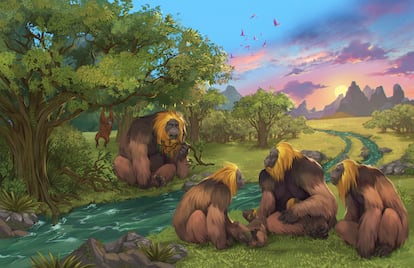How the gigantopithecus, the largest ape that ever walked on Earth, became extinct
‘Gigantopithecus blacki,’ which weighed over 600 lbs, disappeared 250,000 years ago from southern China when it was unable to adapt to changes in its environment

In 1935, the German anthropologist Ralph von Koenigswald walked into a Hong Kong pharmacy and found something that was being sold as a dragon’s tooth, heterogeneous teeth and bones that were crushed to prepare traditional remedies. The scientist, who was searching on the island of Java and Southeast Asia for the cradle of humanity, associated those molars with a gigantic primate that he named Gigantopithecus blacki. Since then, searches have continued for remains of this giant standing three meters tall (nearly 7 ft) and weighing up to 300 kilograms (660 lbs) that for more than a million and a half years walked the karst plains of what is now the Guanxi region, in southern China. After more than 85 years of searching, no skull has been found, leaving a blank space in its spot in the tree of evolution. Only four jaws and about 2,000 teeth have been found in various sites, often dispersed, probably by porcupines that gnawed on their bones to obtain nutrients for their quills. After first emerging two million years ago, its trace was lost about 300,000 years ago. On Wednesday, an international group of scientists published a study in the journal Nature reconstructing the demise of the greatest ape that ever walked the Earth.
One of the key aspects of the study was the dating, which was carried out with six different techniques and precisely demonstrated that the giant primate disappeared between 295,000 and 215,000 years ago. Kira Westaway, a geochronology specialist at Macquarie University in Sydney (Australia) and co-author of the study, explains that dating is one of the main challenges in trying to define the cause of the extinction of a species. “Once you have that information, it is possible to reconstruct what was happening in the environment at that time to try to find causes for the disappearance of G. blacki,” she said. In a tale that has been repeated over and over again in the history of the world, those magnificent animals that had survived for countless generations finally succumbed, when circumstances changed, condemned by the same traits that had made them successful.

“The story of G. blacki is an enigma in paleontology: how could such a powerful creature become extinct at a time when other primates were adapting and surviving? The unsolved cause of its demise has become the Holy Grail of this discipline,” says Yingqi Zhang, from the Institute of Vertebrate Paleontology and Paleoanthropology of the Chinese Academy of Sciences, in a statement.
About 700,000 years ago, the stable environment in which G. blacki had been living began to change. The differences between seasons increased, with more extremes of humidity and drought, and their habitat suffered from weather disruptions. The analysis of pollen remains and the reconstruction of the fauna with which these apes shared their lives show the transformations that forced them to abandon their habits. Unlike its other relatives, the gigantopithecus was a specialized herbivore, enjoying abundant food in the tropical forest. “These relatively small environmental changes took a long time to affect G. blacki, which struggled to adapt as its population declined,” notes Westaway. “It was a gradual path to extinction, not an abrupt event.”
Analysis of the teeth, which over the centuries became larger and capable of processing fibrous foods, show that the ape was adapting in response to ecological change. But it was not enough. The authors compared their diet with that of the Chinese orangutan (Pongo weidenreichi). This species is also extinct today, but in the years of decline of G. blacki was able to adapt its size and diet to more variable conditions in which, sometimes, it was necessary to travel a certain distance to get food or find water that thousands of years earlier had been abundant everywhere. The giant ape was not as mobile and had to settle, according to tooth analysis, for lower quality food when its favorite morsels were missing. Furthermore, its large size makes it likely that it was less prolific, something that undermined the sustainability of the species.
“It was the ultimate specialist, compared to more agile adaptive species like orangutans, and this ultimately led to its demise,” Zhang notes. About 300,000 years ago, the surviving populations of G. blacki became increasingly scarce and the marks on the teeth reflect that the survivors suffered from chronic stress. At that same time and in those same forests, a distant relative of those animals, Homo erectus, successfully adapted to the changing and diverse conditions of Southeast Asia. Although the arrival of Homo sapiens has been linked to the extinction of large animal species, including Neanderthals, it appears that these archaic members of our lineage are not related to the annihilation of the world’s largest apes in history.
“With the threat of a sixth mass extinction event looming over us, there is an urgent need to understand why species become extinct. Exploring the reasons for past unresolved extinctions gives us a good starting point for understanding the resilience of primates and the fate of other large animals, in the past and in the future,” says Westaway.
Sign up for our weekly newsletter to get more English-language news coverage from EL PAÍS USA Edition









































